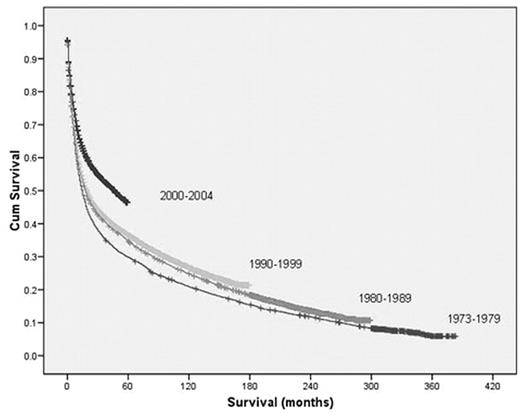Abstract
Introduction: Diffuse large B cell lymphoma (DLBCL) is the most common type of non-Hodgkin lymphoma (NHL). Outcome data of DLBCL among a large population in the United States outside the context of clinical trials has not been reported. We examined survival trends of DLBCL patients among a large population based registry in the last four decades.
Method: Surveillance, Epidemiology, and End Results (SEER) histology codes 9680, 9684, 9697 were used to identify all cases of DLBCL between 1973 and 2004. Kaplan-Meier estimates were used for median overall survival (OS). Variables analyzed included age, race, sex, stage, and year of diagnosis. SPSS statistical software was used for analysis.
Results: Between 1973 and 2004, 59728 cases of DLBCL were recorded in the SEER data. The mean age of diagnosis was 63 years. 32505 (54.4%) were male and 27223 (45.6%) were female. The majority of patients, 51795 (86.7%), were white, 3733 (6.3%) were black, and 4200 (7%) were other races. Staging information was available in 57% of the cases, 18091 (30%) were early stage (I, II), 15862 (27%) were advanced stage (III, IV) and in 25775 (43%) the stage was unknown/missing. The overall median survival was 25 months. The 5 year OS was 36%. The relative 5 year OS was 47%. The median OS for females was 28 months compared to 21 months for males (log rank test, P value < 0.005). The median OS for white patients was 25 months compared to 16 months for black patients (log rank test, P value <0.005). The median OS improved over time. Specifically, for patients diagnosed between 1973–1979, 1980–1989,1990–1999, and 2000–2004 the median OS was 15, 18, 20, and 47 months, respectively (p value <0.005) (see Figure). The improvement in median OS was seen among both sexes, all ages and races. Also, the improvement in OS was seen in both early and advanced stages. For the period 2000–2004, 24,303 patients were identified. Of these 57% were males, 86% were white and 7% were black. Fifty percent were early stage and 44% were advanced stage; the stage was unknown in 6%. The median OS was 47 months. The 4 year overall survival was 46%. The median OS for early stage was not reached and was 19 months for patients with advanced stage (log rank test, p value <0.005). Outcome was better in white patients compared to black patients: 47 months compared to 29 months, respectively (log rank test, p value 0.001). No differences between males and females were noted. The median OS for patients <60 years old was not reached compared to 23 months for patients over the age of 60. In a Cox regression model all variables analyzed (age, sex, race, stage and year of diagnosis by decade) were statistically significant independent factors.
Conclusion: This is the first report on outcome of DLBCL in the SEER data. The outcome of DLBCL in the United States has improved significantly in the era of monoclonal antibodies. Black patients had inferior outcome. No sex differences in outcome are noted in the recent years. The SEER data analysis has several limitations namely lack of accurate staging information, IPI scoring and treatment details.
Author notes
Disclosure: Membership Information: Rami Komrokji, speakers Bureau Genentech.


This feature is available to Subscribers Only
Sign In or Create an Account Close Modal